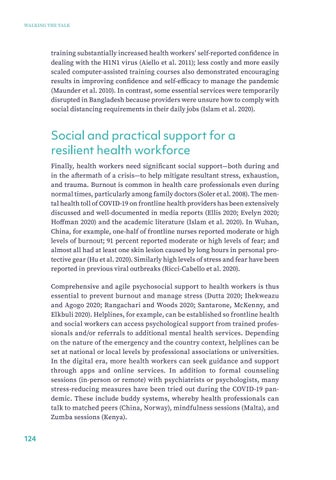WALKING THE TALK
training substantially increased health workers’ self-reported confidence in dealing with the H1N1 virus (Aiello et al. 2011); less costly and more easily scaled computer-assisted training courses also demonstrated encouraging results in improving confidence and self-efficacy to manage the pandemic (Maunder et al. 2010). In contrast, some essential services were temporarily disrupted in Bangladesh because providers were unsure how to comply with social distancing requirements in their daily jobs (Islam et al. 2020).
Social and practical support for a resilient health workforce Finally, health workers need significant social support—both during and in the aftermath of a crisis—to help mitigate resultant stress, exhaustion, and trauma. Burnout is common in health care professionals even during normal times, particularly among family doctors (Soler et al. 2008). The mental health toll of COVID-19 on frontline health providers has been extensively discussed and well-documented in media reports (Ellis 2020; Evelyn 2020; Hoffman 2020) and the academic literature (Islam et al. 2020). In Wuhan, China, for example, one-half of frontline nurses reported moderate or high levels of burnout; 91 percent reported moderate or high levels of fear; and almost all had at least one skin lesion caused by long hours in personal protective gear (Hu et al. 2020). Similarly high levels of stress and fear have been reported in previous viral outbreaks (Ricci-Cabello et al. 2020). Comprehensive and agile psychosocial support to health workers is thus essential to prevent burnout and manage stress (Dutta 2020; Ihekweazu and Agogo 2020; Rangachari and Woods 2020; Santarone, McKenny, and Elkbuli 2020). Helplines, for example, can be established so frontline health and social workers can access psychological support from trained professionals and/or referrals to additional mental health services. Depending on the nature of the emergency and the country context, helplines can be set at national or local levels by professional associations or universities. In the digital era, more health workers can seek guidance and support through apps and online services. In addition to formal counseling sessions (in-person or remote) with psychiatrists or psychologists, many stress-reducing measures have been tried out during the COVID-19 pandemic. These include buddy systems, whereby health professionals can talk to matched peers (China, Norway), mindfulness sessions (Malta), and Zumba sessions (Kenya). 124


